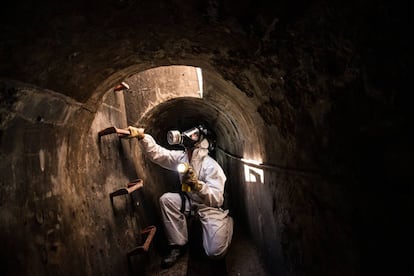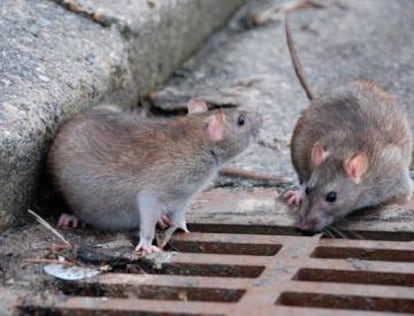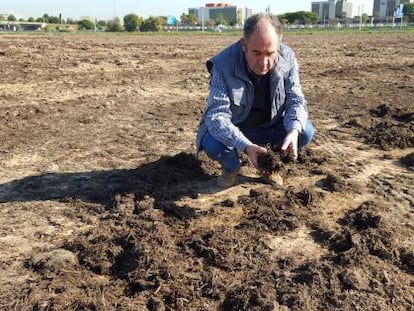Pioneering study finds more than 200,000 rats in Barcelona’s sewers
Many specimens were discovered to be carrying bacteria and worms that can be passed on to humans

Many urban legends hold that there are more sewer rats than people in any given city, but there is no scientific basis for this claim. The fact is, very few of the world’s large metropolises have attempted to tally the number of rodents running around their underground networks. But Barcelona has just become one of the pioneers.
Preliminary results from the Catalan capital’s first census show one sewer rat for every seven local residents, according to a report by the Barcelona Public Health Agency to which EL PAÍS has had access.
Technicians from this city agency and experts from a pest control company called Lokímica carried out the study in 2017, analyzing 63 representative sections of the city’s sewer system for a total of 1,648 kilometers. Thirty traps were set in each sector and checked daily for four consecutive nights. This yielded a figure of around 107,000 rats living inside the more than thousand kilometers of accessible tunnels. By extrapolating that number to the entire sewer system, experts arrived at a figure of 0.13 rodents for every resident of Barcelona, or 213,000 sewer rats in total.
Pest-control employees, sanitation workers and people who go to parks often, especially children, are the main groups at risk of infections
María Teresa Galán, parasitologist
The study, which was headed by Sandra Franco, noted that this is a higher density than in the US city of Baltimore (0.08 rats per person), but lower than New York (0.25).
“The sewers are a parallel world. And gaining access to them is very complex from a logistics viewpoint: many sections are not accessible, others require stopping traffic up at street level, and you need toxic-gas detectors and very strict safety protocols,” explains the biologist Rubén Bueno, the technical director of Lokímica. His company conducts pest control work in Madrid, Valencia, Alicante, Murcia, Palma de Mallorca and Barcelona.

Large cities typically make ballpark estimates of their rat populations based on indirect indicators, such as citizen alerts and rat-poison consumption. “The precision achieved by the Barcelona project had never been achieved before in Spain,” says Bueno.
Disease carriers
The biologist Tomás Montalvo has headed the first bacteriological study of Barcelona’s rats, as part of the same pest-control program designed by the Public Health Agency. The report, titled BCNRATS, analyzed 212 specimens caught inside the tunnels and found that 71% were carrying strains of the bacteria Escherichia coli that are resistant to some antibiotics. Another bacteria, Listeria monocytogenes — which causes miscarriages in pregnant women and meningitis in children – was found in 59% of the rats.
“The risk of human exposure to these pathogens is an important public-health problem,” concluded the team led by Montalvo. Their analysis also found Yersinia enterocolitica in 18% of rats, Leptospira interrogans in 12%; Salmonella enterica in 7%, and Campylobacter jejuni in another 7% of rats. All of these bacteria can be passed to humans and cause dangerous infectious diseases such as leptospirosis.

Yet bacteria are not the only threat to public health, warns the parasitologist María Teresa Galán, of Valencia University. This researcher has analyzed the innards of around a hundred rats caught in Barcelona’s sewer system, and found that 85% of the animals had worm infestations. Some cases were of particular concern: 17% of the specimens were carrying Hymenolepis nana, a parasite whose eggs can be ingested by humans, leading to intestinal worms of up to four centimeters in length. Another 17% of rats were carrying Calodium hepaticum, another parasite that lives in people’s livers.
“Pest control employees, sanitation workers and people who go to parks often, especially children, are the main groups at risk of infections,” warns Galán’s team in the specialized publication Veterinary Parasitology. This is the first study of its kind in Spain, its authors say. “In parks and gardens the risk of infection is very low, but every year someone ‘wins the big lottery prize’,” says the researcher.
Sewer rats or Norway rats, known scientifically as Rattus norvegicus, arrived in Spain from China in the 19th century, and now live in the entire territory. The females are breeding machines that reach sexual maturity at eight weeks of age. After that, they can have up to seven litters in a single year, with 11 to 14 young to a litter. Some specimens have been known to grow to the size of a rabbit, proving too intimidating even for cats.
English version by Susana Urra.
Tu suscripción se está usando en otro dispositivo
¿Quieres añadir otro usuario a tu suscripción?
Si continúas leyendo en este dispositivo, no se podrá leer en el otro.
FlechaTu suscripción se está usando en otro dispositivo y solo puedes acceder a EL PAÍS desde un dispositivo a la vez.
Si quieres compartir tu cuenta, cambia tu suscripción a la modalidad Premium, así podrás añadir otro usuario. Cada uno accederá con su propia cuenta de email, lo que os permitirá personalizar vuestra experiencia en EL PAÍS.
¿Tienes una suscripción de empresa? Accede aquí para contratar más cuentas.
En el caso de no saber quién está usando tu cuenta, te recomendamos cambiar tu contraseña aquí.
Si decides continuar compartiendo tu cuenta, este mensaje se mostrará en tu dispositivo y en el de la otra persona que está usando tu cuenta de forma indefinida, afectando a tu experiencia de lectura. Puedes consultar aquí los términos y condiciones de la suscripción digital.
More information
Archived In
Últimas noticias
Most viewed
- Reinhard Genzel, Nobel laureate in physics: ‘One-minute videos will never give you the truth’
- Pablo Escobar’s hippos: A serious environmental problem, 40 years on
- Charles Dubouloz, mountaineering star, retires at 36 with a farewell tour inspired by Walter Bonatti
- Why we lost the habit of sleeping in two segments and how that changed our sense of time
- The Florida Keys tourist paradise is besieged by immigration agents: ‘We’ve never seen anything like this’













































